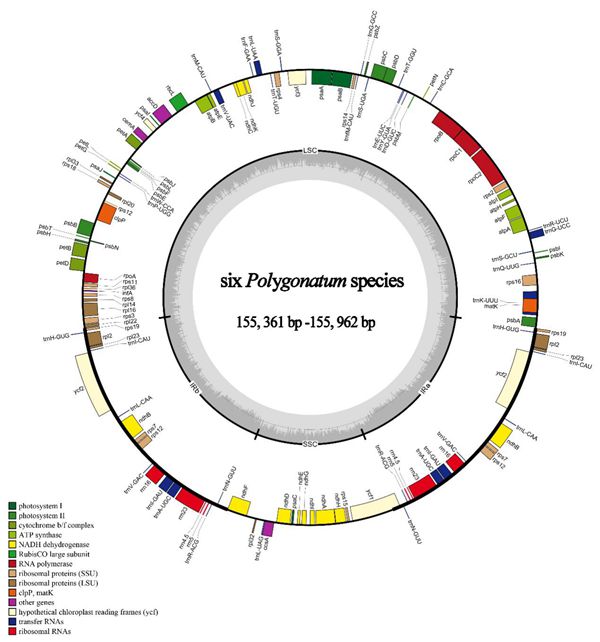Name:HU Guangwan
Tell:
Email:guangwanhu@wbgcas.cn
Organization:Wuhan Botanical Garden
Complete Chloroplast Genomes Enlighten the Phylogenetic Placement of Six Polygonatum Species
2023-06-07
Polygonatum Miller is valued significantly for its medicinal properties with the horizontal creeping fleshy roots. Previous studies have mainly been concerned with the size and gene contents of the plastid genome, with insufficient studies on the comparative genomic analysis. Moreover, the complete chloroplast genome data of some species have not been published, thus their phylogenetic placement is not well understood.
A research team led by Prof. HU Guangwan from Wuhan Botanical Garden reported the initial complete chloroplast genome of P. campanulatum, and then conducted comparative and phylogenetic analysis of the complete chloroplast genomes of six Polygonatum species.
The chloroplast genome showed a typical quadripartite structure, with the length between 154, 564 and 156, 028 bp in Polygonatum. A total of 113 unique genes were detected in each of the species. Comparative analysis revealed that the genome size, gene content, gene order and Guanine-cytosine (GC) content maintained a high similarity in the chloroplast genomes of Polygonatum and Heteropolygonatum.
All the species showed no significant contraction or expansion in the IR boundaries except for P. sibiricum1, in which the rps19 gene presented to be a pseudogene, due to the incomplete duplication. Abundant long dispersed repeats and simple sequence repeats (SSRs) were detected in each genome.
Five highly variable regions were found to be potential specific DNA barcodes, and 14 genes were revealed under positive selection and a large variety of repetitive sequences were identified.
62 chloroplast sequences of Polygonatum and its related species were utilized for phylogenetic analyses. The results illustrated that Polygonatum could be divided into two significant clades, sect.Verticillata and sect. Sibirica plus sect. Polygonatum. Further, P. campanulatum and P. tessellatum + P. oppositifolium were strongly supported to be sister relationship and located in sect. Verticillata, suggesting that leaf arrangement appeared not suitable as basis for delimitation of subgeneric groups in Polygonatum. Additionally, P. franchetii was sister to P. stenophyllum within sect. Verticillata, too.
This research provides more chloroplast genomic information of Polygonatum and contributes to improving species identification and phylogenetic studies in further work.
This study has been published in Scientific Reports entitled "Comparative and Phylogenetic Analysis of the Complete Chloroplast Genomes of SixPolygonatumSpecies (Asparagaceae)". (Published: 04 May 2023)

Gene map of the chloroplast genome among the six Polygonatum species (Image by WBG)